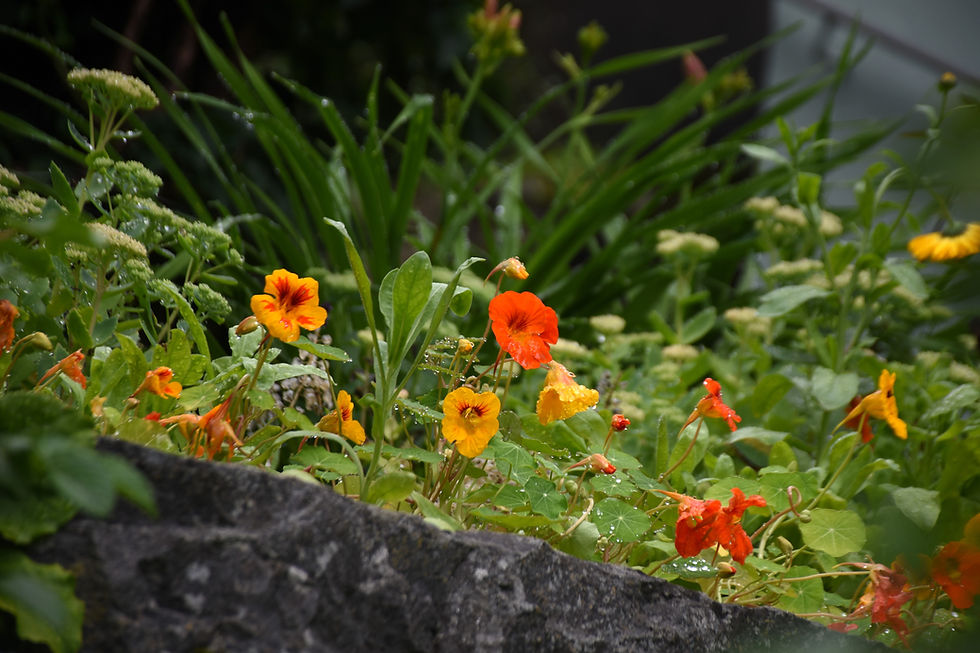Spring Planting - Colours or Edibles, or both?
- The other Tina
- Oct 9, 2023
- 3 min read

Home gardeners everywhere are getting busy breathing life back into their outdoor spaces, we know now is the perfect time to prepare your garden for a season of growth.
One of the decisions you’ll face is whether to focus on a garden bursting with
vibrant colour or to create an edible oasis that delights the eyes and fuels the summer kitchen.
In this blog post, we'll explore the considerations involved in making this choice
and guide you through the process of preparing your garden for spring planting.
🧐 Consider Your Garden's Purpose
Before getting started with the planning process, it's important to consider your garden's primary purpose. Are you aiming to establish a beautiful display of colours, scents, and textures? Or do you envision a practical space that yields fresh produce for your culinary adventures?
This decision will help to shape your planning.
🌸🥬 Combining Colour and Edibles
If the answer is that you want them both, then there is no reason to limit
yourself to one option. Many gardeners ingeniously merge ornamental
plants with edible varieties, achieving a wonderful balance between
aesthetic appeal and functional utility - the best of both worlds!
Selecting Your Plants

1. Creating a Colourful Garden
If you have opted for a garden brimming with colour, it means making
plant selections based on aesthetics. Look for flowering plants such as
Marigolds, Salvia or Gazinias. Consider bloom times to ensure a continuous
display of colour from spring through summer, our team at The Greenery can help you pick out a great selection.

2. Cultivating an Edible Garden
If you prefer practicality and fresh produce, focus on selecting vegetables,
herbs, and fruit-bearing plants that are suitable for the climate and your
growing conditions - and what you know you will use. Tomatoes, lettuce,
peppers, strawberries, and herbs like basil, mint, and thyme are popular
choices but plant your favourites in a place you either can see from the house or pass by regularly, this will give you and your garden the best chance of success!

3. Blending the Best of Both Worlds
You can section off your blooms and veges or merge the two. Consider edible flowers such as nasturtiums or courgettes, or colourful chillis and mini peppers 🌶️ come and see us we can find the perfect pairing for you.
4. Embracing Native Plants

When selecting plants for your garden, it's worth considering the benefits
of including native species. Native plants are well-suited to your region's
climate, soil, and wildlife. They often require less maintenance and
watering, contributing to a more sustainable and eco-friendly garden.
Native plants can attract local pollinators and wildlife, enhancing the biodiversity of your outdoor space.
Had a think about it? Got your dream garden in mind? Ok, let's get that ground ready!
Garden Preparation
1. Feed your Soil
Healthy plants start with healthy soil. Adding compost, well-rotted manure,
or organic matter can help improve soil structure, drainage, and nutrient
content. Turning the soil and working the soil food into the ground, will
provide a fertile foundation for your plants to thrive in. Check out our blog on this to go into more detail.
2. Planting Layout
Design your garden layout based on your chosen plants. Consider factors
such as plant height, spacing requirements, exposure to the wind and sunlight needs. Optimal spacing facilitates improved air circulation, reducing the risk of disease. Spend some time in your garden location noticing what's going on, does the water pool somewhere? Does the wind whip through?
3. Think about seasonal Maintenance
Both colourful and edible gardens require consistent care during the
growing season. Regular watering, mulching, weeding, and pest control
are some of the tasks.
The choice to emphasise colour or edibles in your garden depends on personal
choice and preference. The key lies in finding the balance that resonates with
your tastes and lifestyle.
Happy planting!










Comments